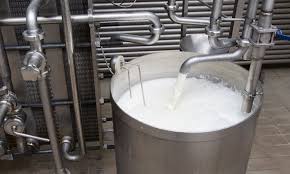Agriculture Notes On – Milk Pasteurization – For W.B.C.S. Examination.
There is a general and urgent need for rapid procedures, applicable to process control, to monitor food safety and quality.Continue Reading Agriculture Notes On – Milk Pasteurization – For W.B.C.S. Examination.
- Pasteurization is a process in which certain packaged and non-packaged foods (such as milk and fruit juice) are treated with mild heat, usually less than 100 °C (212 °F), to eliminate pathogens and extend shelf life.
- The process safeguards foods by destroying or inactivating organisms that contribute to spoilage, including vegetative bacteria but not bacterial spores.
- The process was named after the French scientist Louis Pasteur, whose research in the 1880s demonstrated that thermal processing would inactivate unwanted microorganisms in wine.
- Today, pasteurization is used widely in the dairy industry and other food processing industries to achieve food preservation and food safety.
Different Types of Thermal Processing Methods
- Thermization: Heat the milk to between 57°C to 68°C and hold for 15 minutes. Thermization targets pathogenic bacteria while leaving the good bacteria in the product. The low temperatures do not alter the structure and taste of the milk.
- Batch pasteurization: Also known as low-temperature long time (LTLT) pasteurization. Heat the milk to 63°C for 30 minutes. The extended holding time causes the alteration in the milk protein structure and taste.
- Flash pasteurization: Also known as high-temperature short time (HTST) pasteurization. Heat the milk to between 72°C to 74°C for 15 to 20 seconds. Targets resistant pathogenic bacteria spores (Clostridium botulinum spores).
- Ultra-high temperature (UHT) pasteurization: Heat the milk to between 135°C to 140°C for 2 to 4 seconds. The extreme heat targets Coxiella burnetii, which causes Q-fever. The heat kills all the vegetative forms of bacteria and the milk can survive for 9 months.
- Canned sterilization: This is a wet treatment of canned milk products in an autoclave/specialized treatment chambers. Heat to between 115°C to 121°C for 10 to 20 minutes.
Milk Pasteurization
- Milk pasteurization is the process of heating milk (or milk product) to a predetermined temperature for a specified period without re-contamination during the entire process.
- The predetermined temperature usually depends on the heat resistance of spoilage microorganism that the pasteurization program is targeting to destroy.
High-Temperature Short Time (HTST) Pasteurization
- This type of pasteurization is also known as flash pasteurization.
- Flash pasteurization involves heating milk to 71.7°C for 15 seconds to kill Coxiella burnetii, which is the most heat resistant pathogen in raw milk.
- Since it is technically impossible to bring the milk to that exact temperature, it is always safe to work with a range of temperatures. To be safe, you can heat the milk to between 72°C to 74°C for 15 to 20 seconds.
- This will ensure that the milk is heated uniformly to the required temperature.
- This method is most suitable in continuous pasteurization systems.
- Flash pasteurized milk will keep for between 16 and 21 days. For commercial reasons, some manufacturers intentionally reduce the number of days to push the products out of the shelves.
Low-Temperature Long Time (LTLT) pasteurization
- Here, the temperatures used for pasteurization are reduced to 63°C and held for 30 minutes.
- The prolonged holding period alters the structure of the milk proteins making it better suited for making yogurt.
- This method is best for batch pasteurization where the milk is held in a jacketed vat for effective pasteurization.
- There are many designs of batch pasteurizers in the market that are suitable for both domestic and commercial use.
Ultra High Temperature (UHT) Pasteurization
- This is a completely closed pasteurization method. The product is never exposed even for a fraction of a second during the entire process.
- It involves heating milk or cream to between 135°C to 150°C for one to two seconds, then chilling it immediately and aseptically packaging it in a hermetic (air-tight) container for storage.
- Despite the risk of Millard browning, UHT pasteurization remains the most popular milk preservation method for safe and stable milk.
Please subscribe here to get all future updates on this post/page/category/website


 +919674493673
+919674493673  mailus@wbcsmadeeasy.in
mailus@wbcsmadeeasy.in







































































































